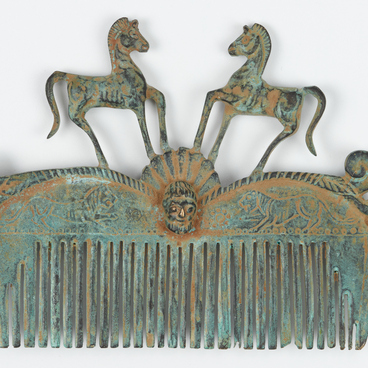Researchers assume that the first toys for children were simply treated stones and shaped bones. The Mergen ‘doll’ is displayed in the Ishim collection. It is dated to 4000 years old. The curved sculpture was made out of clay. The figurine resembled a baby wrapped in a sheet or an embryo. The facial elements of the doll have decayed, but two small pits are visible on it. These were eyes. The craftsmen applied longitudinal lines on the surface of the doll that look like horizontal impressions. There was a hole at the narrowed end of the figurine, on the backside, to which a wooden stick could be attached. It is possible that the ‘doll’ was an amulet for women and was associated with the cult of the mother, birth, and fertility.
The Mergen ‘doll’ is a rare archaeological find. It was discovered in 2003 during excavations on Lake Mergen, near the village of Sorochkino in the Ishim district. The lake is considered to be one of the largest in the Lower Priishimye forest-steppe area, its length is about 11 kilometers. The water source is located near the banks of the Ishim River and stretches from northwest to southeast parallel to the riverbed. Many artifacts of early human settlements and burial grounds of different eras have been found around this location. The abundance of fish and nesting places of waterfowl in the reed thickets near the lakeshores attracted hunters and fishermen.
The research was organized by the Ishim Museum of Local History. Specialists of the Human Paleoecology laboratory of The Siberian Branch of the Russian Academy of Sciences that worked on the site admit that the tradition of creating embryo-like sculptures originated within the forest-steppe and Ishim-Irtysh south taiga interfluve area. Later, such ‘dolls’ were made in the adjacent territories and further, up to Scandinavia.
Clay embryo-like shaped figurines were found during excavations. Similar finds were made by archaeologists at the Late Neolithic and Early Metal settlement sites in the Lake Onega basin (Karelia). ‘Dolls’, similar to the Mergen ones, were discovered in Latvia, Estonia, and Finland.
The Mergen ‘doll’ is a rare archaeological find. It was discovered in 2003 during excavations on Lake Mergen, near the village of Sorochkino in the Ishim district. The lake is considered to be one of the largest in the Lower Priishimye forest-steppe area, its length is about 11 kilometers. The water source is located near the banks of the Ishim River and stretches from northwest to southeast parallel to the riverbed. Many artifacts of early human settlements and burial grounds of different eras have been found around this location. The abundance of fish and nesting places of waterfowl in the reed thickets near the lakeshores attracted hunters and fishermen.
The research was organized by the Ishim Museum of Local History. Specialists of the Human Paleoecology laboratory of The Siberian Branch of the Russian Academy of Sciences that worked on the site admit that the tradition of creating embryo-like sculptures originated within the forest-steppe and Ishim-Irtysh south taiga interfluve area. Later, such ‘dolls’ were made in the adjacent territories and further, up to Scandinavia.
Clay embryo-like shaped figurines were found during excavations. Similar finds were made by archaeologists at the Late Neolithic and Early Metal settlement sites in the Lake Onega basin (Karelia). ‘Dolls’, similar to the Mergen ones, were discovered in Latvia, Estonia, and Finland.



